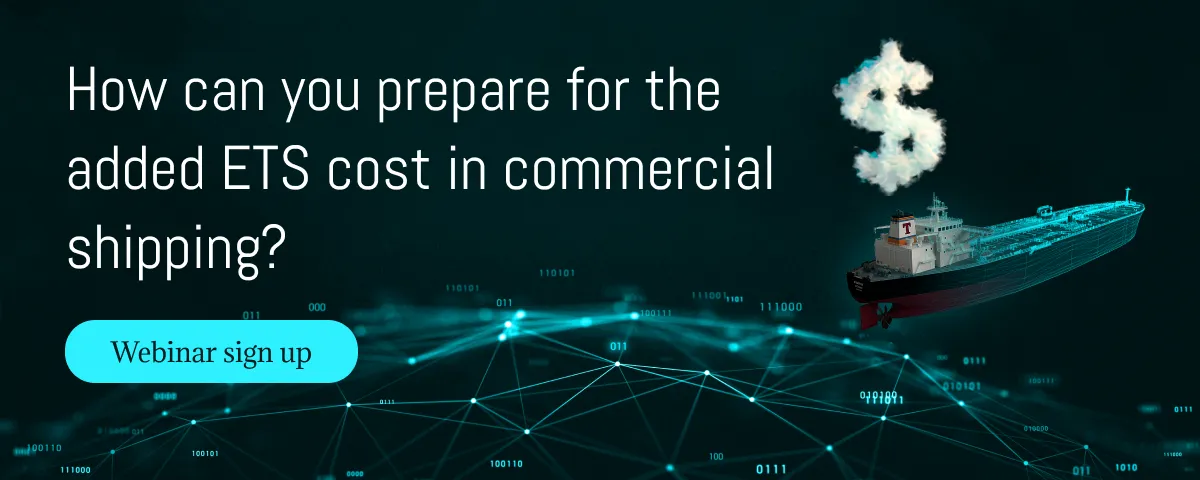Lorem ipsum dolor sit amet, consectetur adipiscing elit. Suspendisse varius enim in eros elementum tristique. Duis cursus, mi quis viverra ornare, eros dolor interdum nulla, ut commodo diam libero vitae erat. Aenean faucibus nibh et justo cursus id rutrum lorem imperdiet. Nunc ut sem vitae risus tristique posuere.
Shipping’s inclusion in the European Union’s Emissions Trading System (EU ETS) brought carbon pricing to the maritime sector. For charterers who want to leverage the opportunities of the transition, it’s time to embrace the change and learn how to navigate the EU ETS. A good way to start is to understand how the new regulations impact your everyday work. So, we sum up some key aspects of the EU ETS - from a chartering perspective.
The EU ETS (more info in fact box below) is a key tool for combating climate change and reducing greenhouse gas emissions cost-effectively. The maritime industry was included in the emissions trading scheme in January 2024, and shipping companies are required to purchase EU Allowances for their carbon emissions.
Below, we explore the key aspects of the EU ETS from a chartering perspective.
There are no free allowances for the maritime industry. However, a phase-in period of requirements for the shipping industry is scheduled as follows:
Now, let's talk about the impact on freight rates, because the added carbon cost from the inclusion of shipping in the EU ETS is eventually passed on to the cost of freight. For example, at a rate of EUR 90/tonne of CO2, the added carbon cost of a typical EU internal voyage in the MR segment is roughly EUR 70,000.
But let's not just see this as a cost, let's see it as an opportunity! If you’re proactive you can leverage the possibilities that come with factoring carbon into your commercial decisions. So, it's time to embrace the changes, stay ahead of the game, and make money while making a positive impact on the shipping industry and the planet.
Are you wondering how the carbon cost will impact your shipping program? Or do you have questions about the inclusion of shipping in the EU ETS? Sign up for our on-demand webinar.

THE EUROPEAN UNION'S EMISSIONS TRADING SYSTEM
The EU ETS is a key tool for EU policy makers to combat climate change and for reducing greenhouse gas (GHG) emissions cost-effectively. It is the first largest and longest running international system for trading emissions allowances. The system today:
Since 2005 the EU ETS has set a cap on the total amount of GHG emissions that companies can emit each year. A fixed number of allowances, which are the currency of the carbon market, are issued. The cap is reduced over time so that total emissions fall. Within the cap, installations buy or receive emissions, which they can trade with one another as needed.
An EU allowance, or an EUA, is a permit to emit 1 tonne of carbon dioxide or its equivalent (CO2e). The price of the EUA fluctuates and can be followed at the European Energy Exchange (EEX).
The EU ETS (more info in fact box below) is a key tool for combating climate change and reducing greenhouse gas emissions cost-effectively. The maritime industry was included in the emissions trading scheme in January 2024, and shipping companies are required to purchase EU Allowances for their carbon emissions.
Below, we explore the key aspects of the EU ETS from a chartering perspective.
There are no free allowances for the maritime industry. However, a phase-in period of requirements for the shipping industry is scheduled as follows:
Now, let's talk about the impact on freight rates, because the added carbon cost from the inclusion of shipping in the EU ETS is eventually passed on to the cost of freight. For example, at a rate of EUR 90/tonne of CO2, the added carbon cost of a typical EU internal voyage in the MR segment is roughly EUR 70,000.
But let's not just see this as a cost, let's see it as an opportunity! If you’re proactive you can leverage the possibilities that come with factoring carbon into your commercial decisions. So, it's time to embrace the changes, stay ahead of the game, and make money while making a positive impact on the shipping industry and the planet.
Are you wondering how the carbon cost will impact your shipping program? Or do you have questions about the inclusion of shipping in the EU ETS? Sign up for our on-demand webinar.
